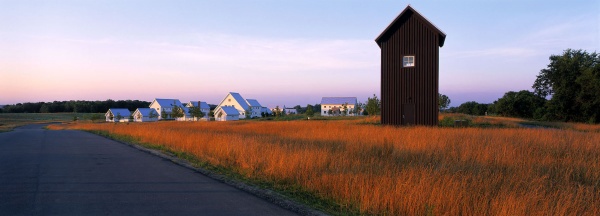i like optimists. used to be one. but i've had a little too much experience with lowest-common-denominator developers - and even some clients that are supposed to be working in the public good (institutional clients) - to accept that we don't need to have some additional stakeholder in the mix to work for the larger built environment.
local planning and design authorities/commissions are embattled and overwhelmed with every little housing development that paves too much, stop-n-shops that ignore sign ordinances, and banks that don't attach enough gew-gaws to deal meaningfullly with the larger built environment.
backpedal: they are, however, the entity i'm looking for, if they could attack urban issues forcefully enough. while there are also always 1 or 2 local wealthy patrons that take on some visibly public-minded work (bringing in their star designers), the public projects that are initiated out of planning agencies are among the few investments that do seem to rise above the insular standard fare.
this internal initiation of projects by the planning and design agencies seems much more successful (despite orhan's correct assessment of some wrong-headed misinvestment in streetscape projects) than their enforcement of 'transparent' guidelines and codes. when i hear a developer fighting hard against tree-protection requirements, limitations on impermeable surface, or propety line fence heights along urban sidewalks, it's hard to see them as allies in making urban improvements. the role of the agency in these cases is to try to keep things less bad than to try to get more good.
ok so i don't like the tone of my last. i sounded like a curmudgeon with my 'been there' attitude. in fact, i'm always looking for ways to address public interest in private projects, whether for developers or otherwise. but i don't yet feel that i have the tools to combat the attitudes that include: arguments of too much cost to look beyond the clients immediate needs, things agencies are 'making me do', etc. i often find myself in conflict with people in my own office when i take the side of what serves a larger good vs their what serves our client in combatting the agencies' 'arbitrary' requirements. when i see a conversation like this one, i hope to find something i can use. (sorry if i'm off point.)
. it does take an artist's touch to make infrastructure beautiful.
So how do we convince business-as-usual developers to create places, not just homes? When engineers apply formulas to create plats and lots on a subdivision, we end up with predictably bad results. So as Designers/Urbanists/'Scapers, what can we do to fight back?
Infrastructure vs...
otherwords, what can we still imagine in terms of a society when known economies have collapsed. with no money, what can we build?
i like optimists. used to be one. but i've had a little too much experience with lowest-common-denominator developers - and even some clients that are supposed to be working in the public good (institutional clients) - to accept that we don't need to have some additional stakeholder in the mix to work for the larger built environment.
local planning and design authorities/commissions are embattled and overwhelmed with every little housing development that paves too much, stop-n-shops that ignore sign ordinances, and banks that don't attach enough gew-gaws to deal meaningfullly with the larger built environment.
backpedal: they are, however, the entity i'm looking for, if they could attack urban issues forcefully enough. while there are also always 1 or 2 local wealthy patrons that take on some visibly public-minded work (bringing in their star designers), the public projects that are initiated out of planning agencies are among the few investments that do seem to rise above the insular standard fare.
this internal initiation of projects by the planning and design agencies seems much more successful (despite orhan's correct assessment of some wrong-headed misinvestment in streetscape projects) than their enforcement of 'transparent' guidelines and codes. when i hear a developer fighting hard against tree-protection requirements, limitations on impermeable surface, or propety line fence heights along urban sidewalks, it's hard to see them as allies in making urban improvements. the role of the agency in these cases is to try to keep things less bad than to try to get more good.
ok so i don't like the tone of my last. i sounded like a curmudgeon with my 'been there' attitude. in fact, i'm always looking for ways to address public interest in private projects, whether for developers or otherwise. but i don't yet feel that i have the tools to combat the attitudes that include: arguments of too much cost to look beyond the clients immediate needs, things agencies are 'making me do', etc. i often find myself in conflict with people in my own office when i take the side of what serves a larger good vs their what serves our client in combatting the agencies' 'arbitrary' requirements. when i see a conversation like this one, i hope to find something i can use. (sorry if i'm off point.)
. it does take an artist's touch to make infrastructure beautiful.

So how do we convince business-as-usual developers to create places, not just homes? When engineers apply formulas to create plats and lots on a subdivision, we end up with predictably bad results. So as Designers/Urbanists/'Scapers, what can we do to fight back?
*bump*
it's been almost a year since we had fun with this thread...
Make that 3 lol
Block this user
Are you sure you want to block this user and hide all related comments throughout the site?
Archinect
This is your first comment on Archinect. Your comment will be visible once approved.